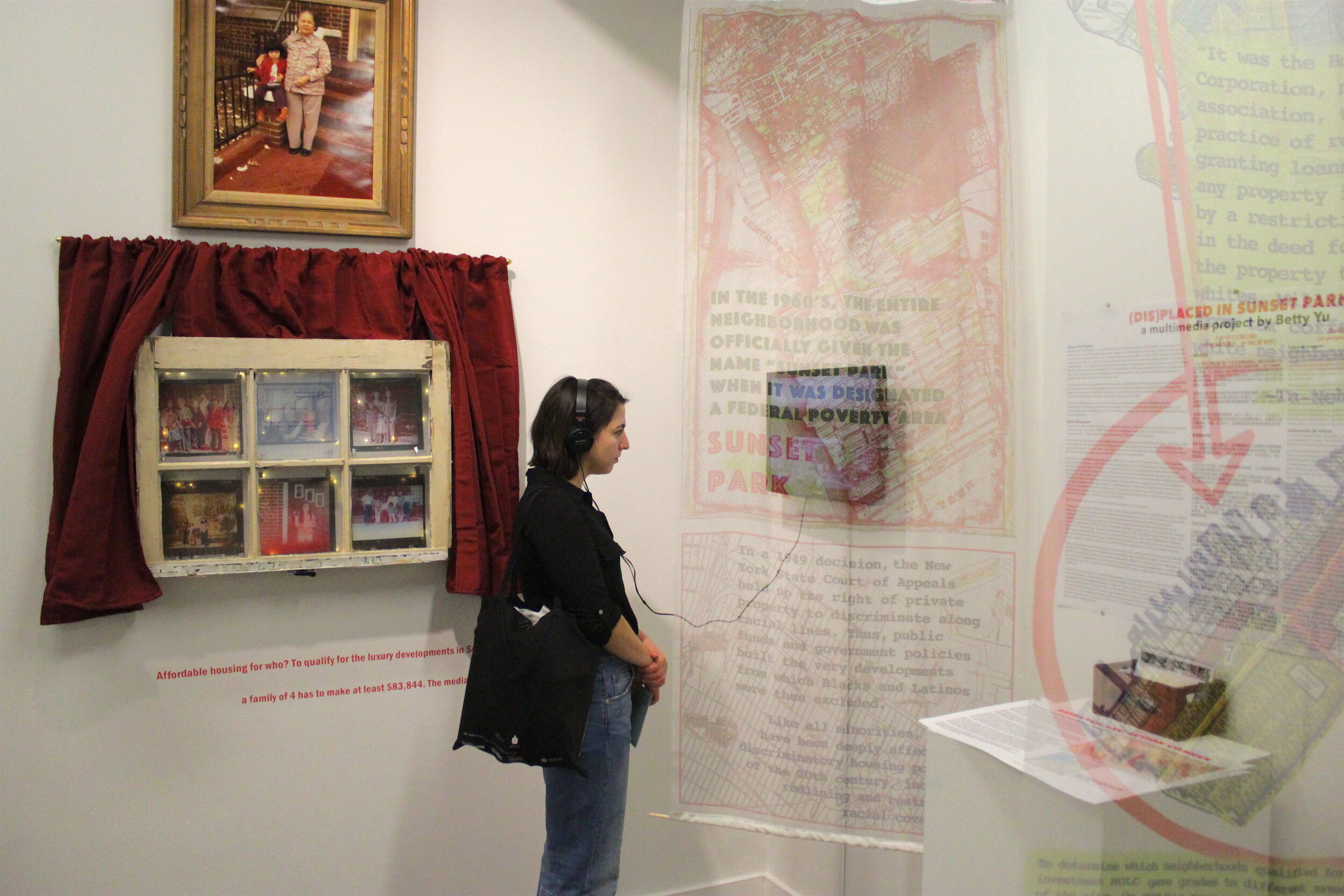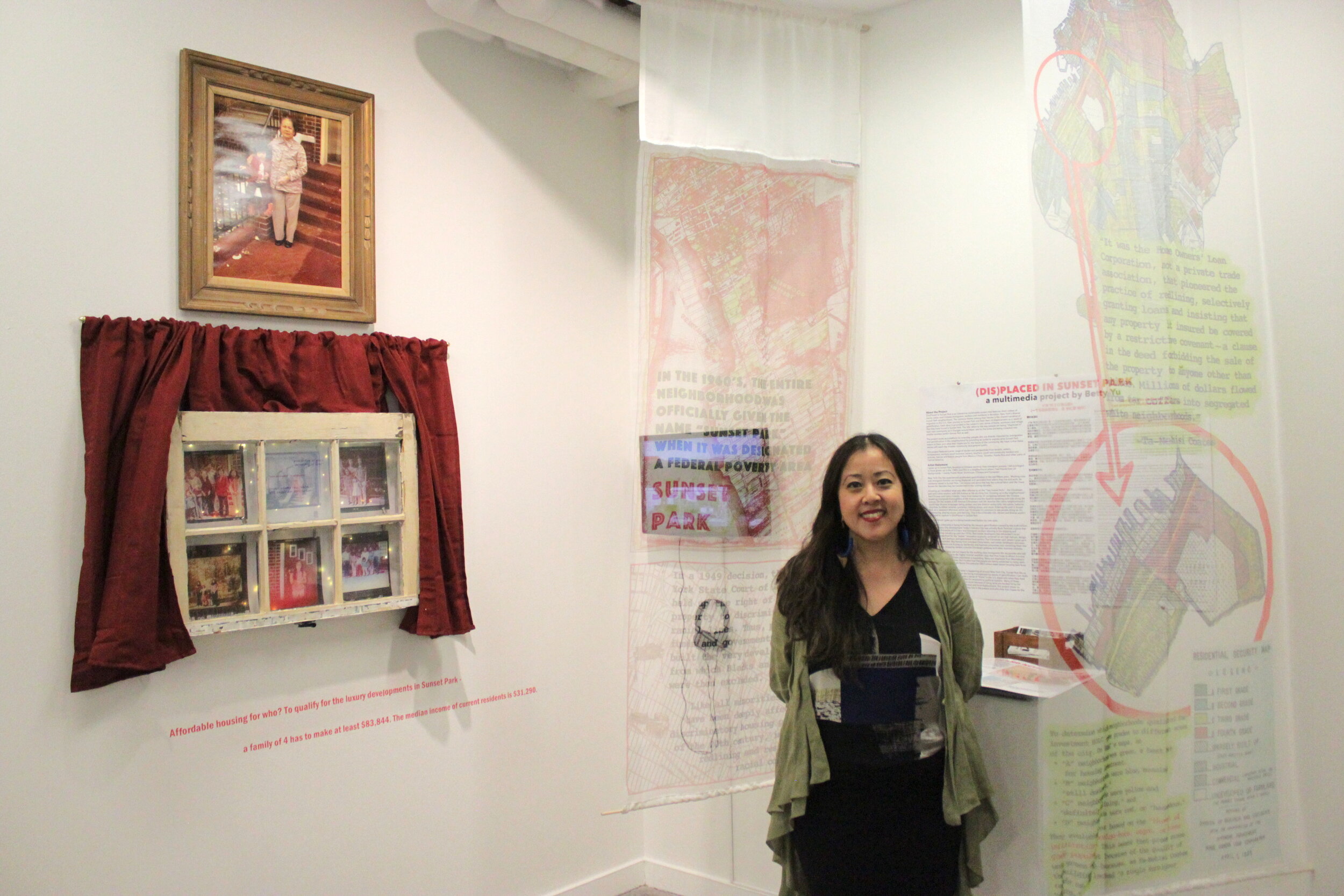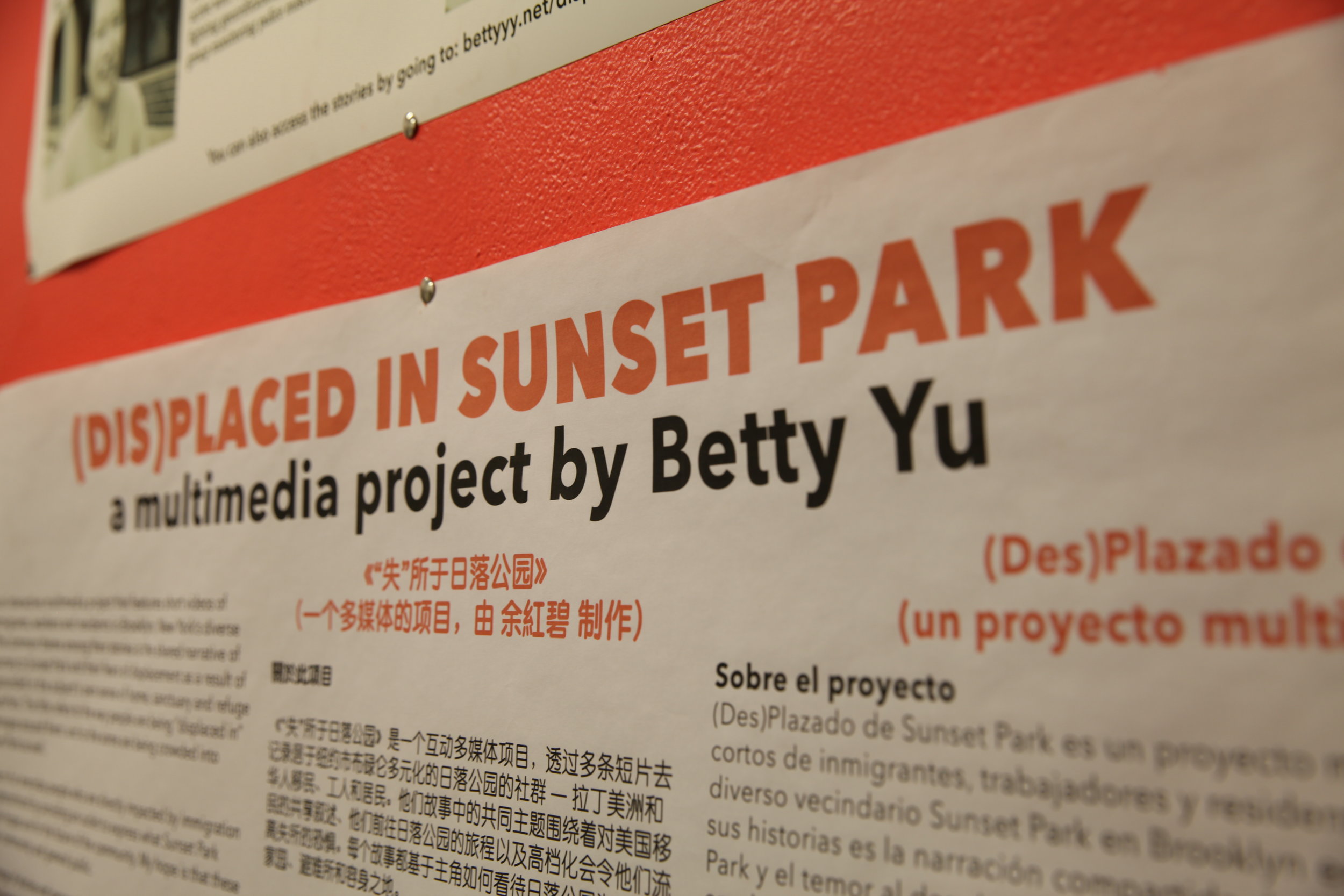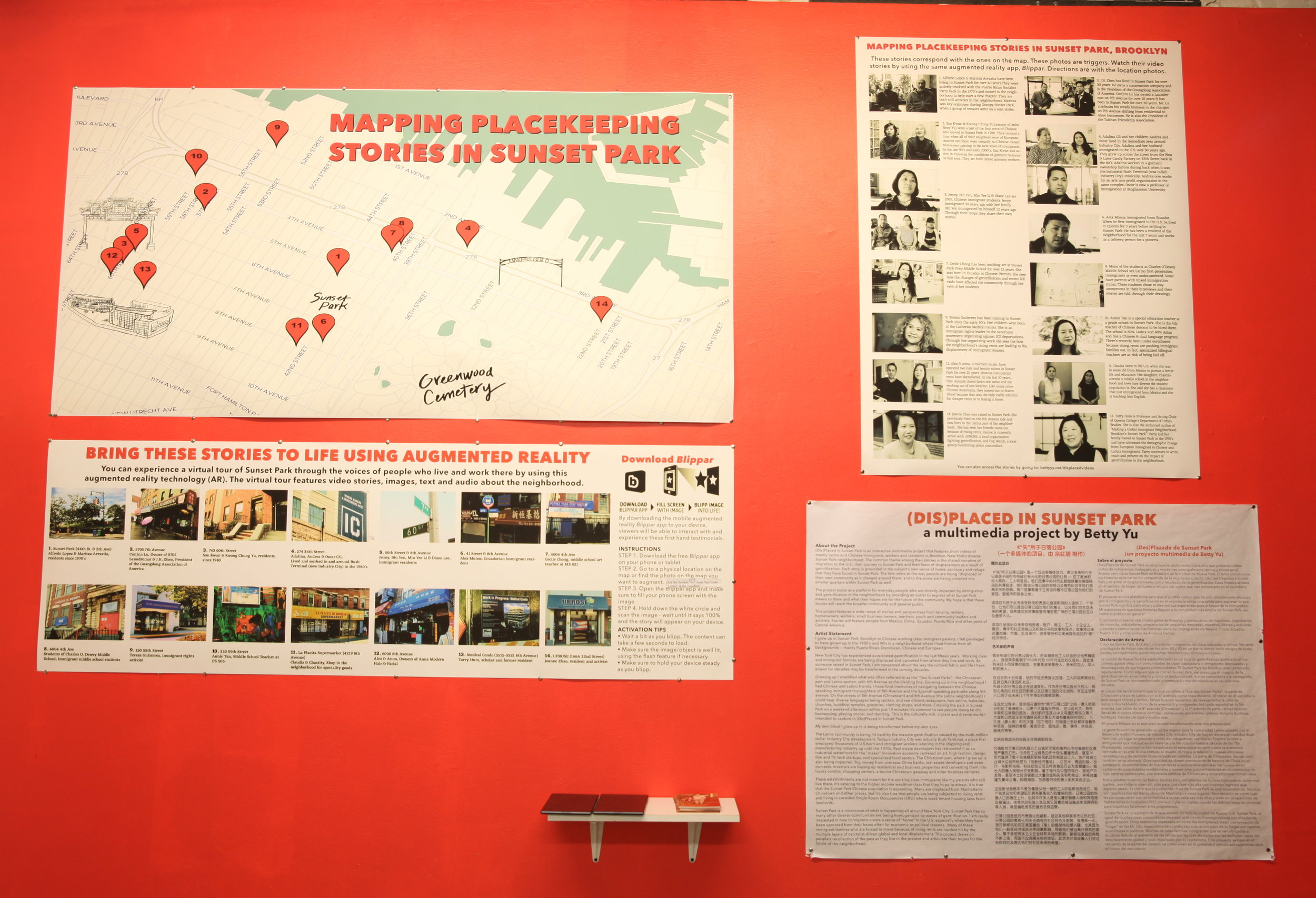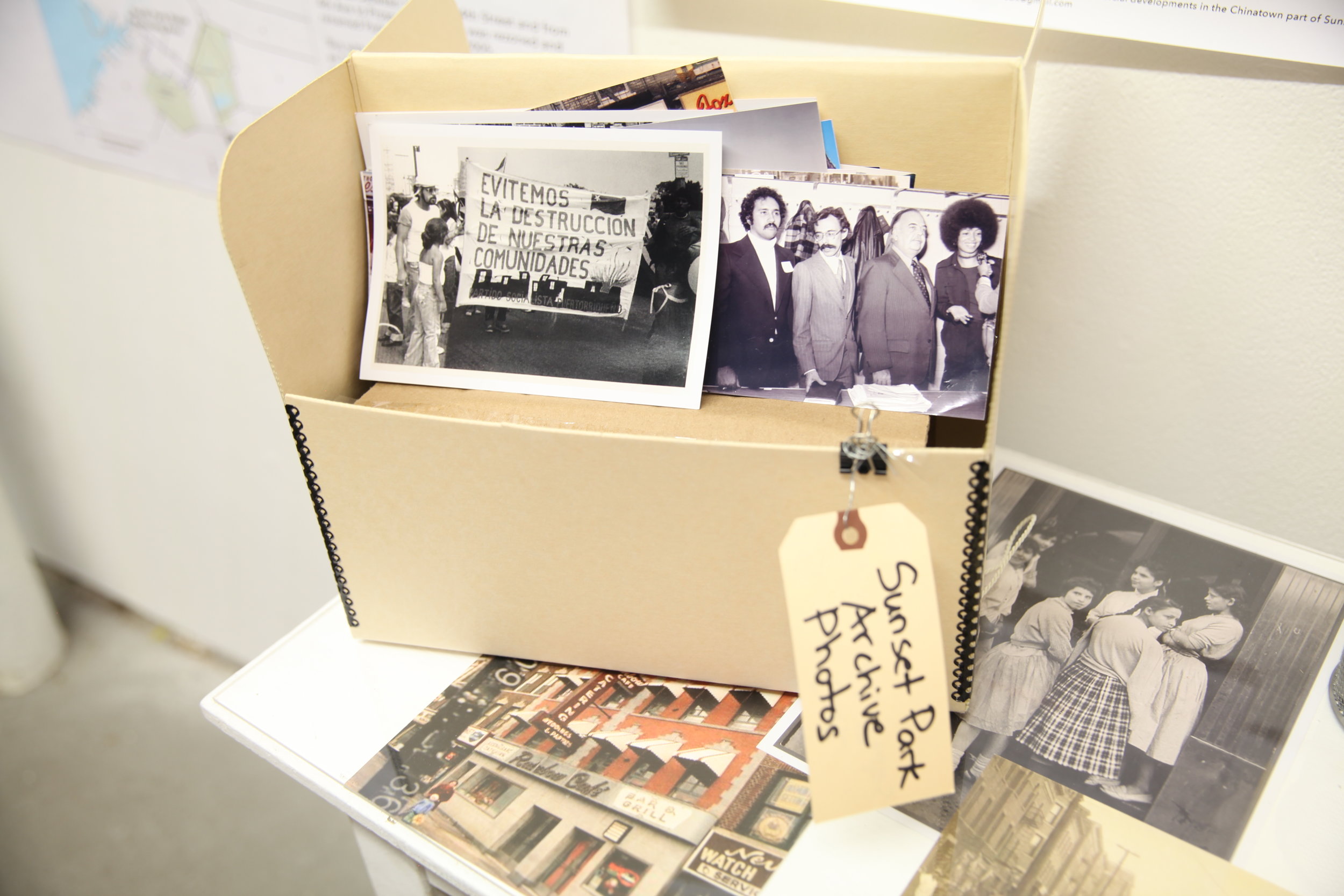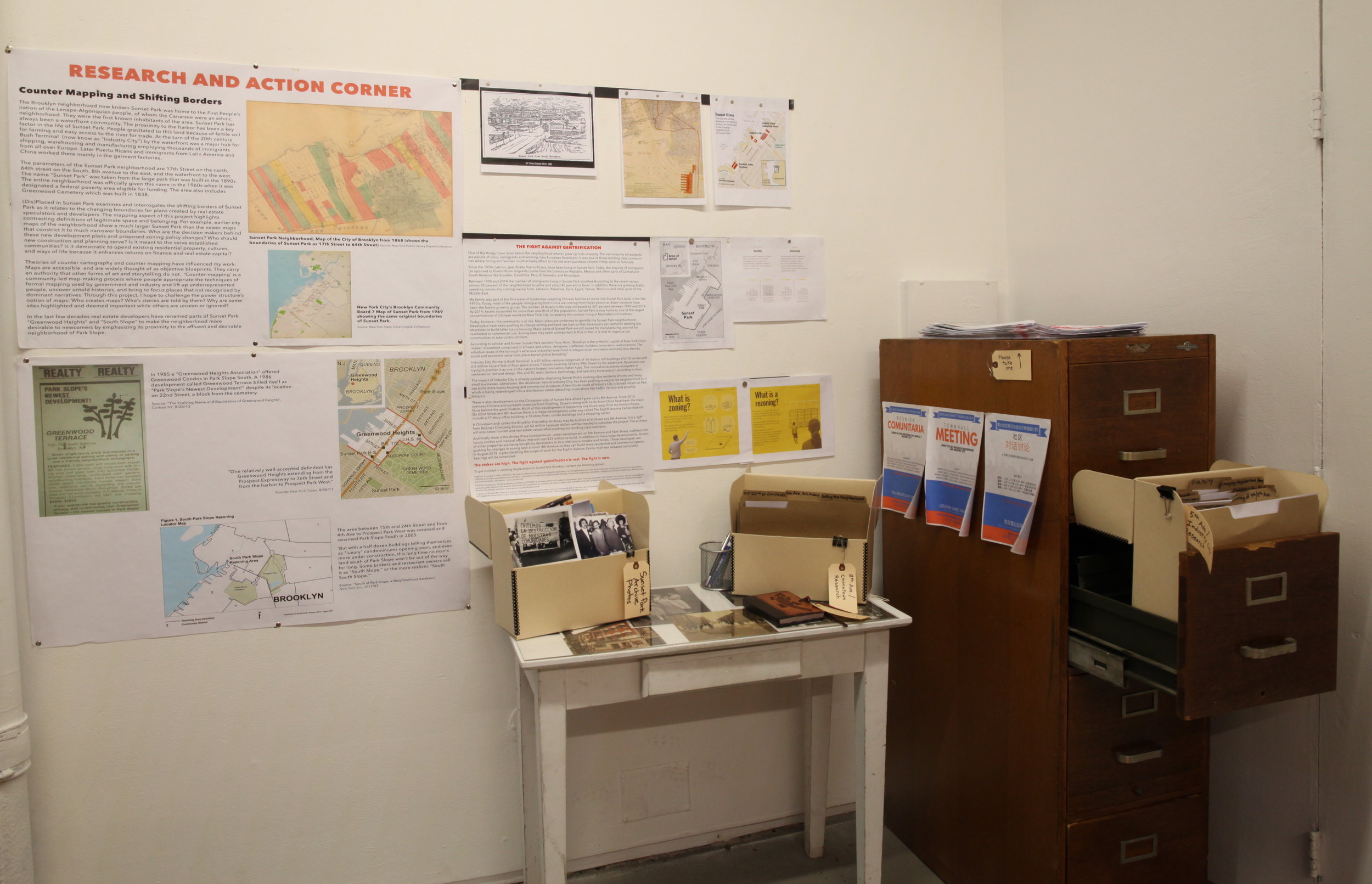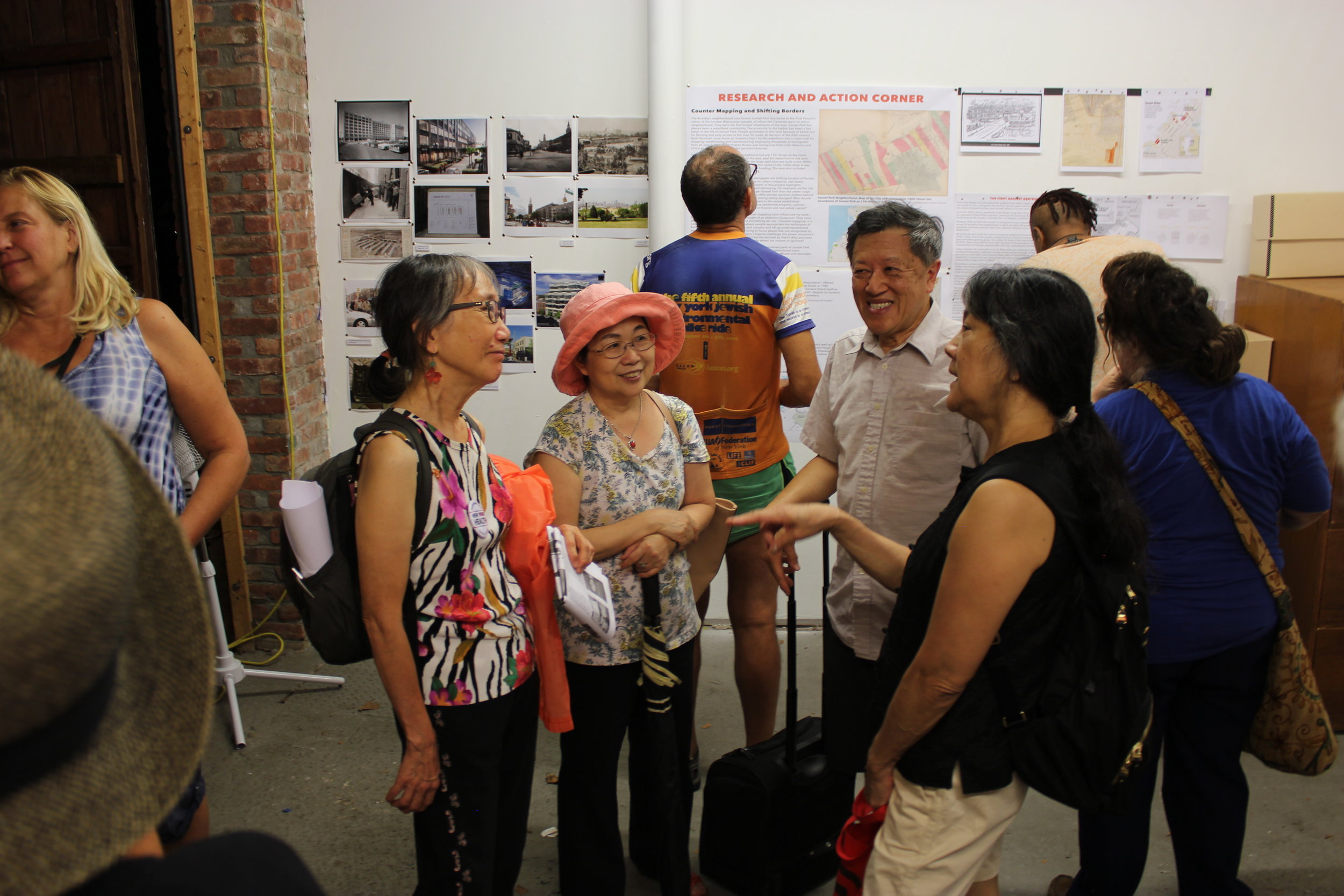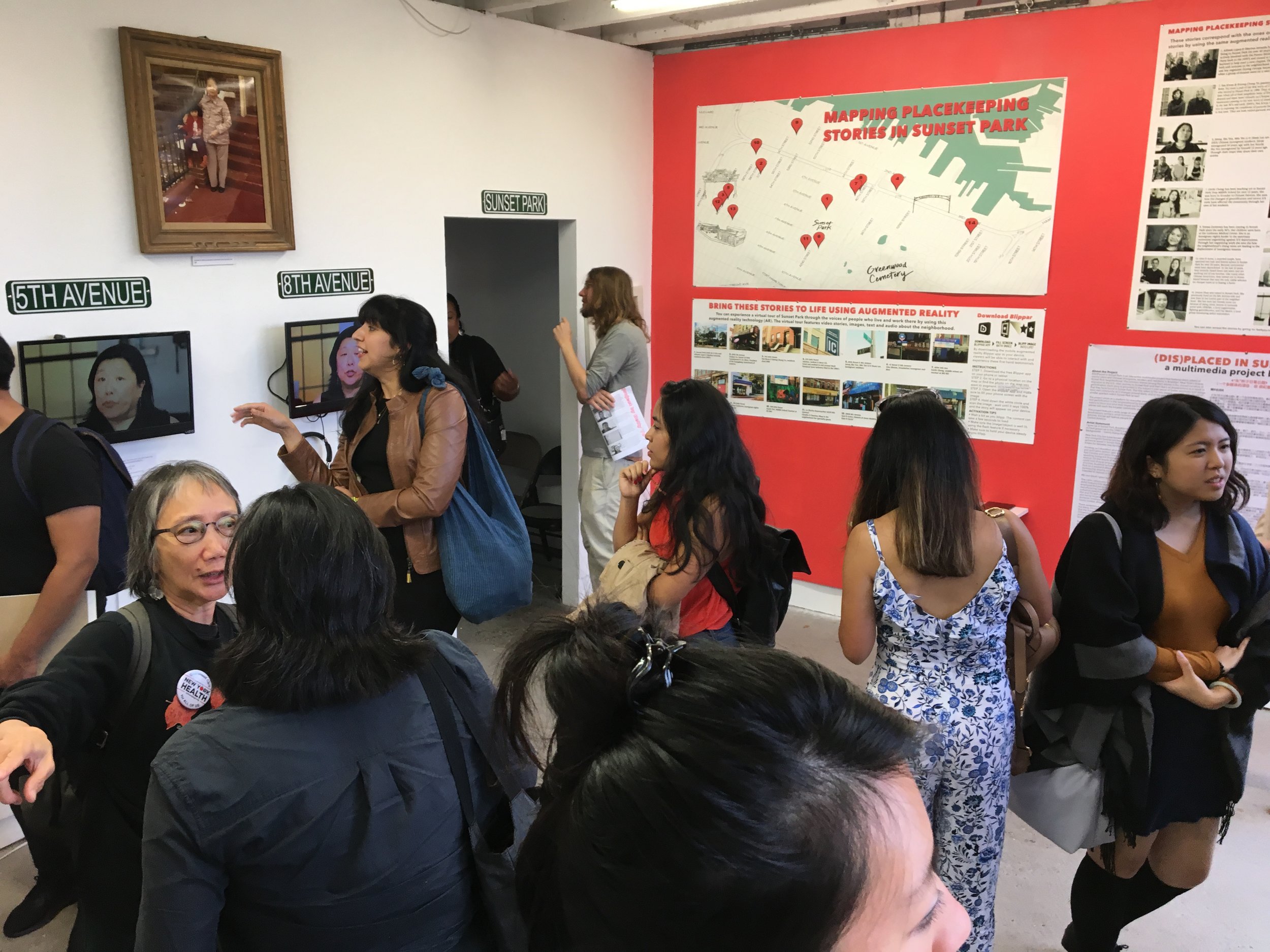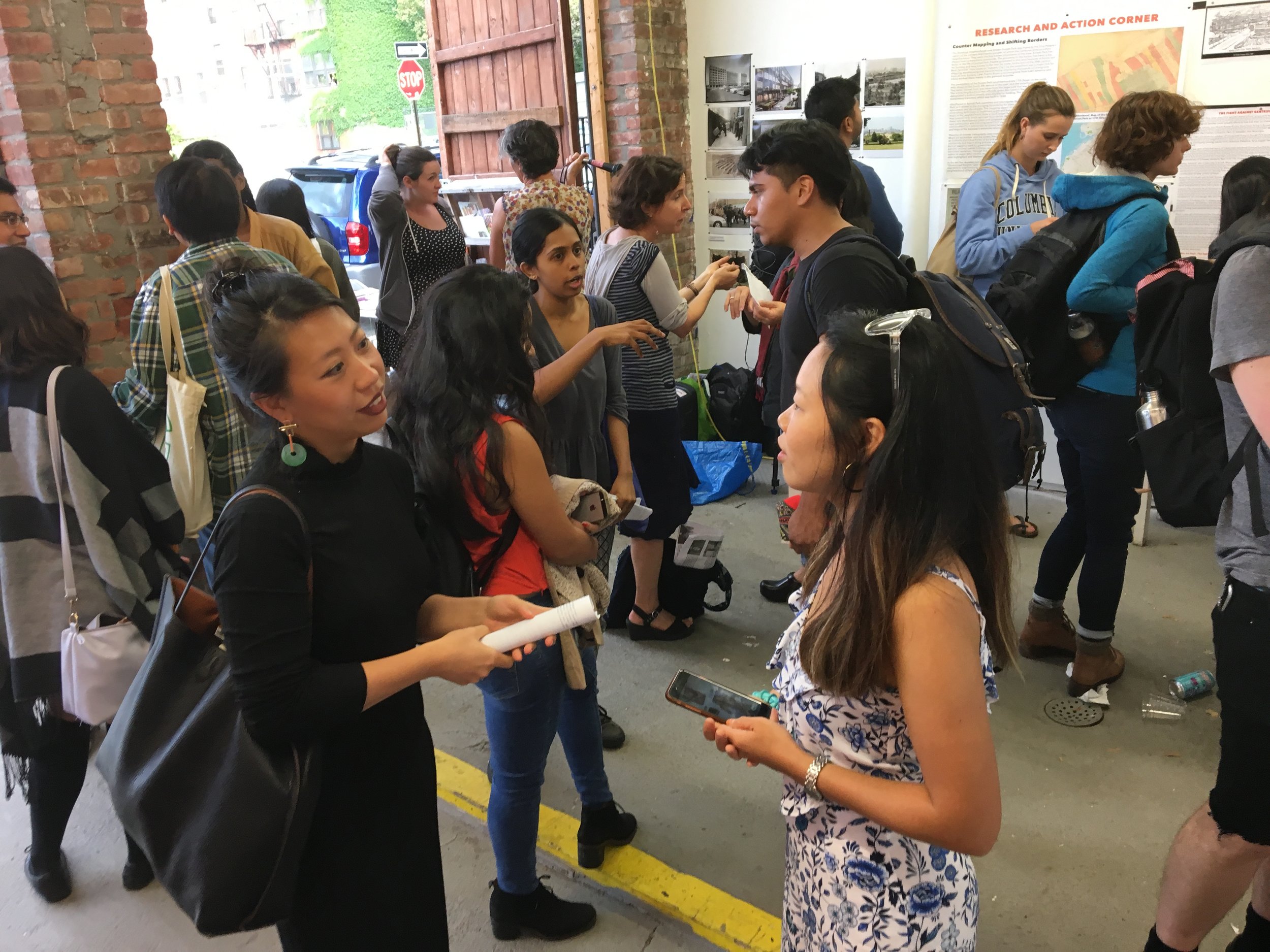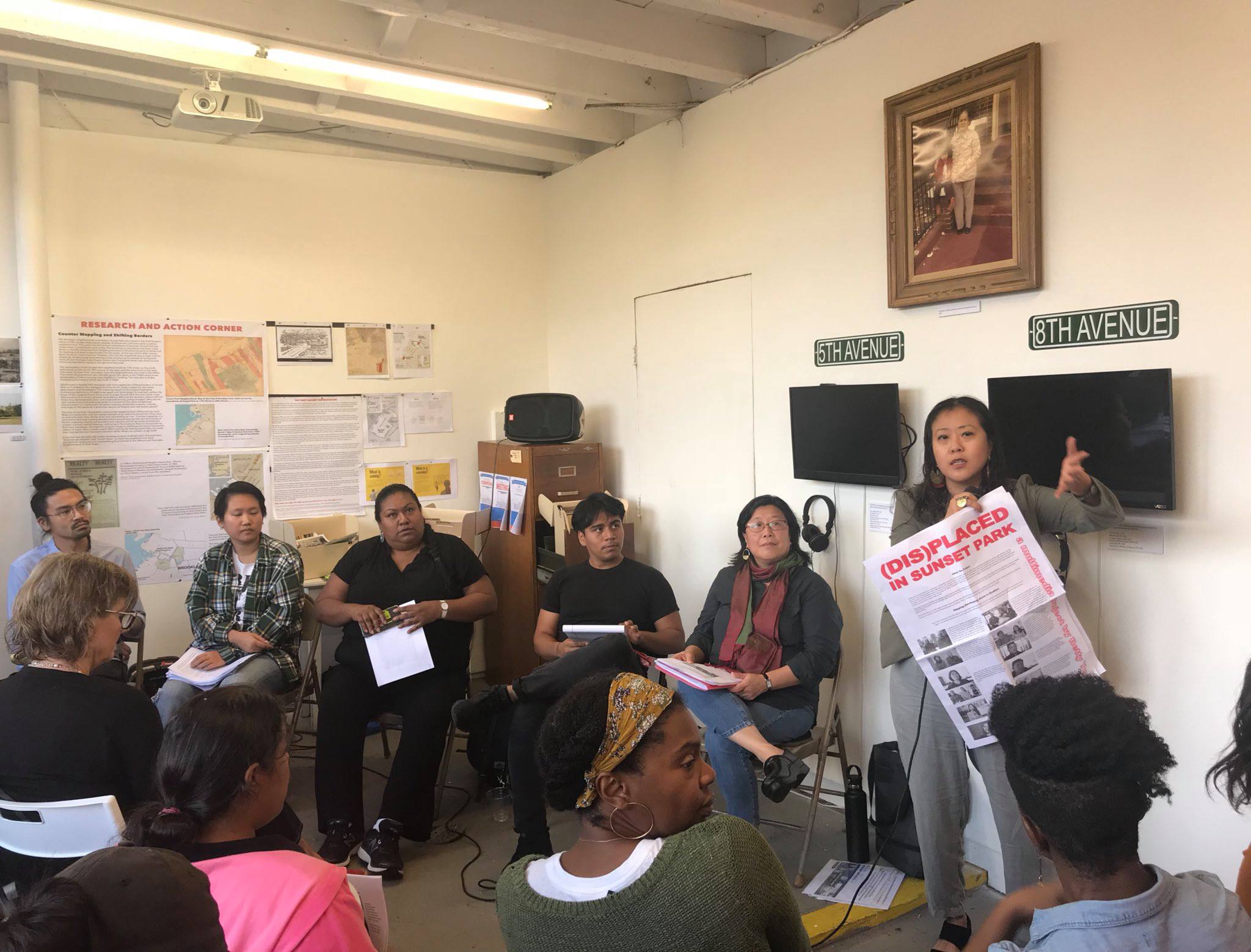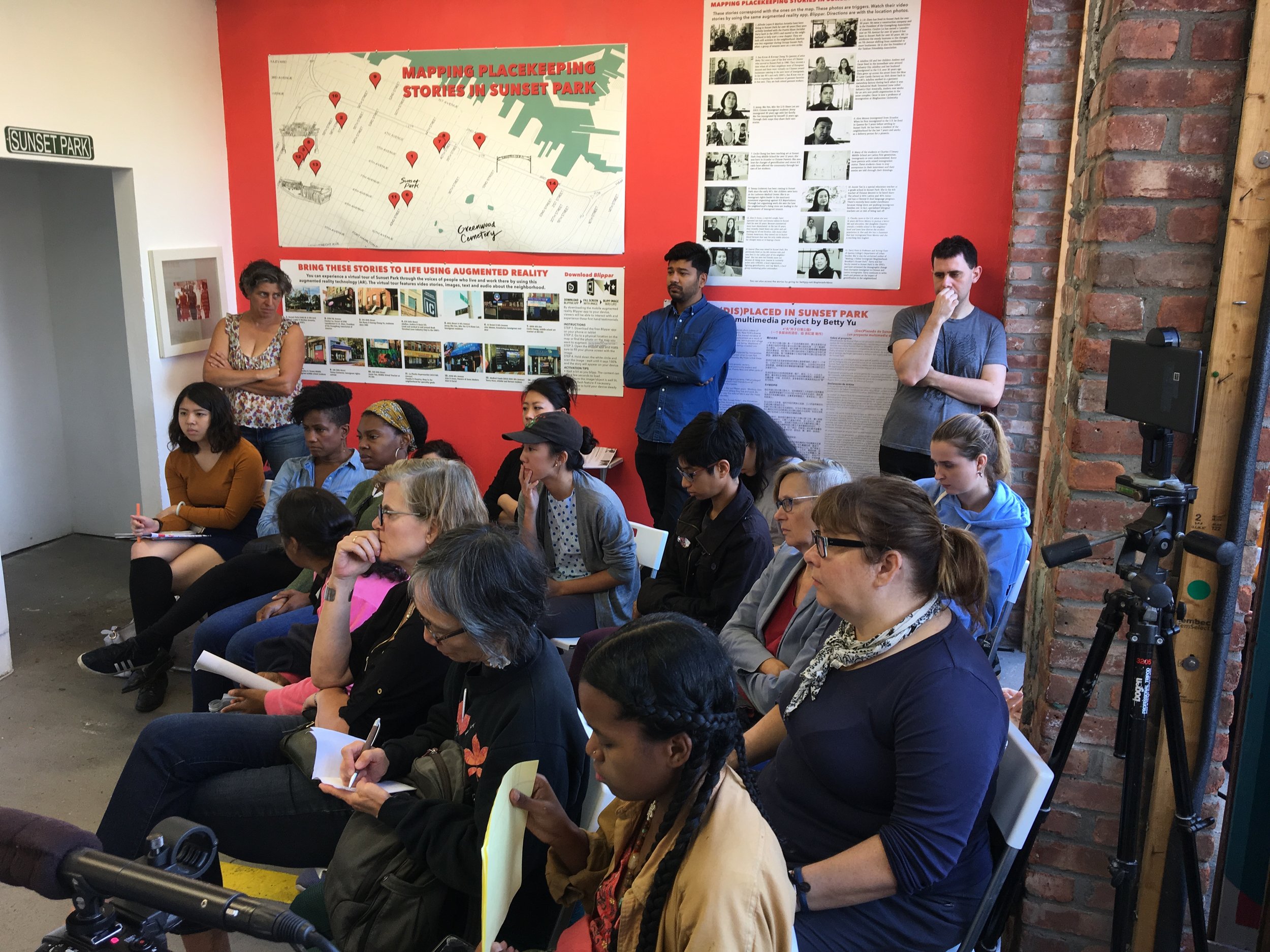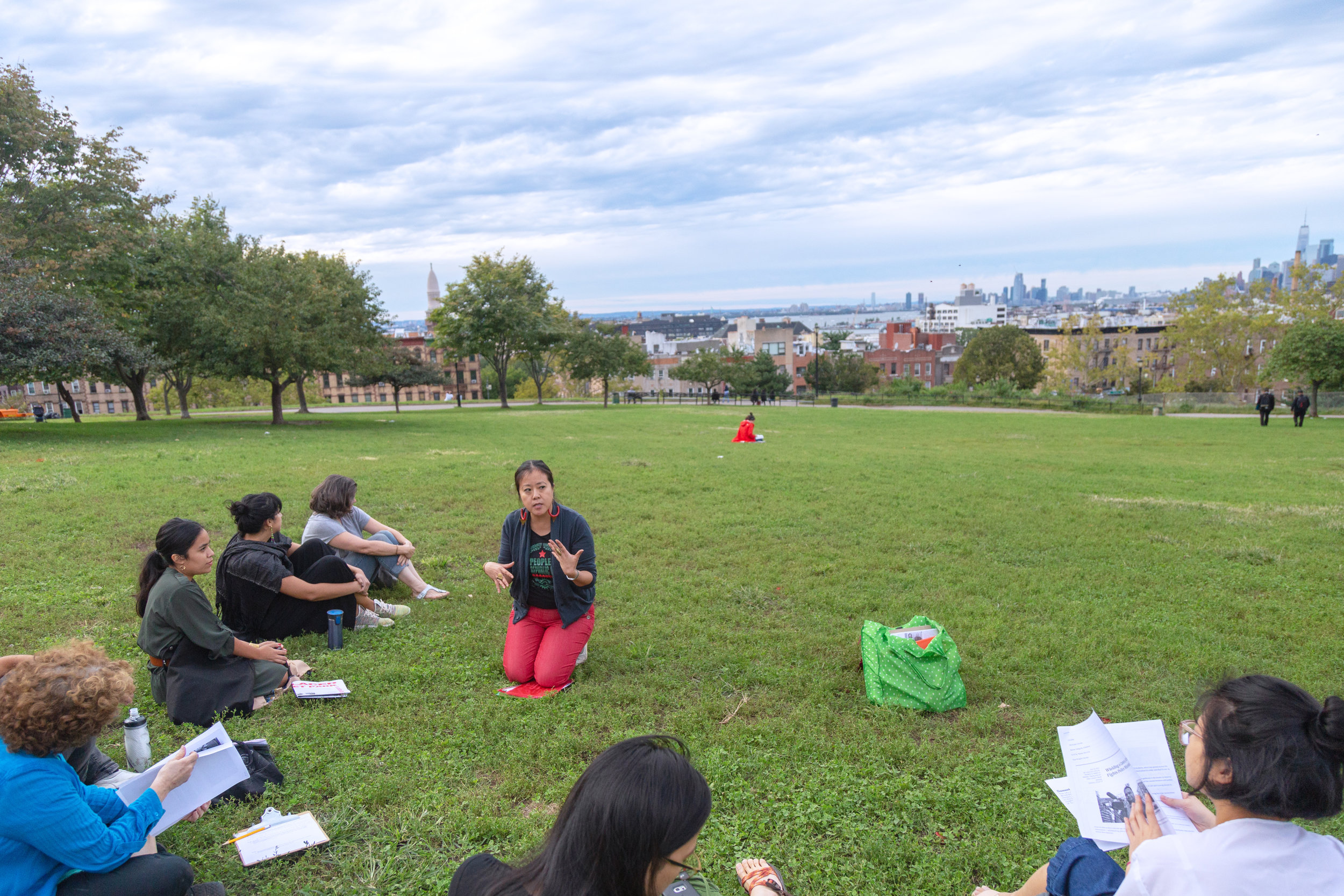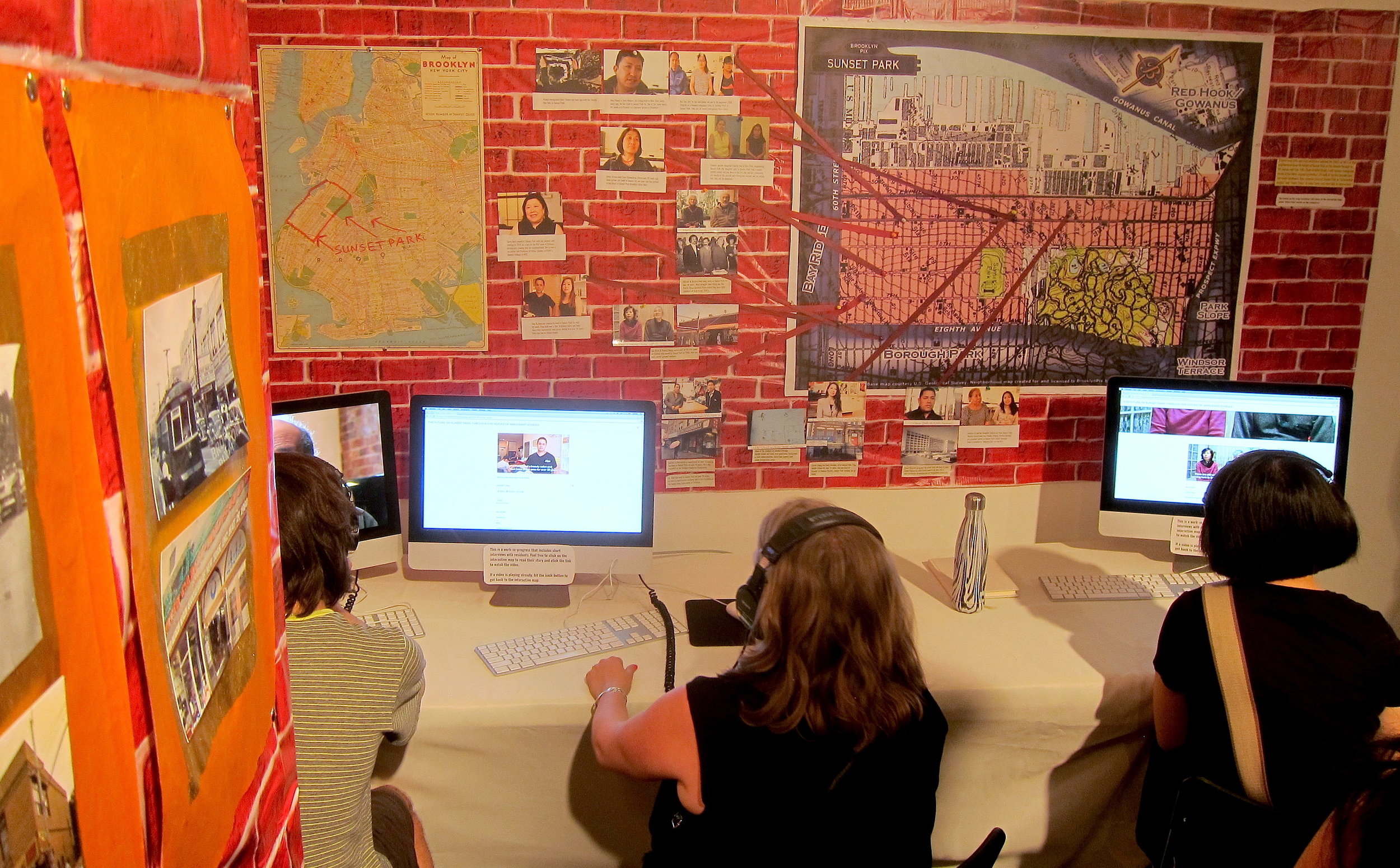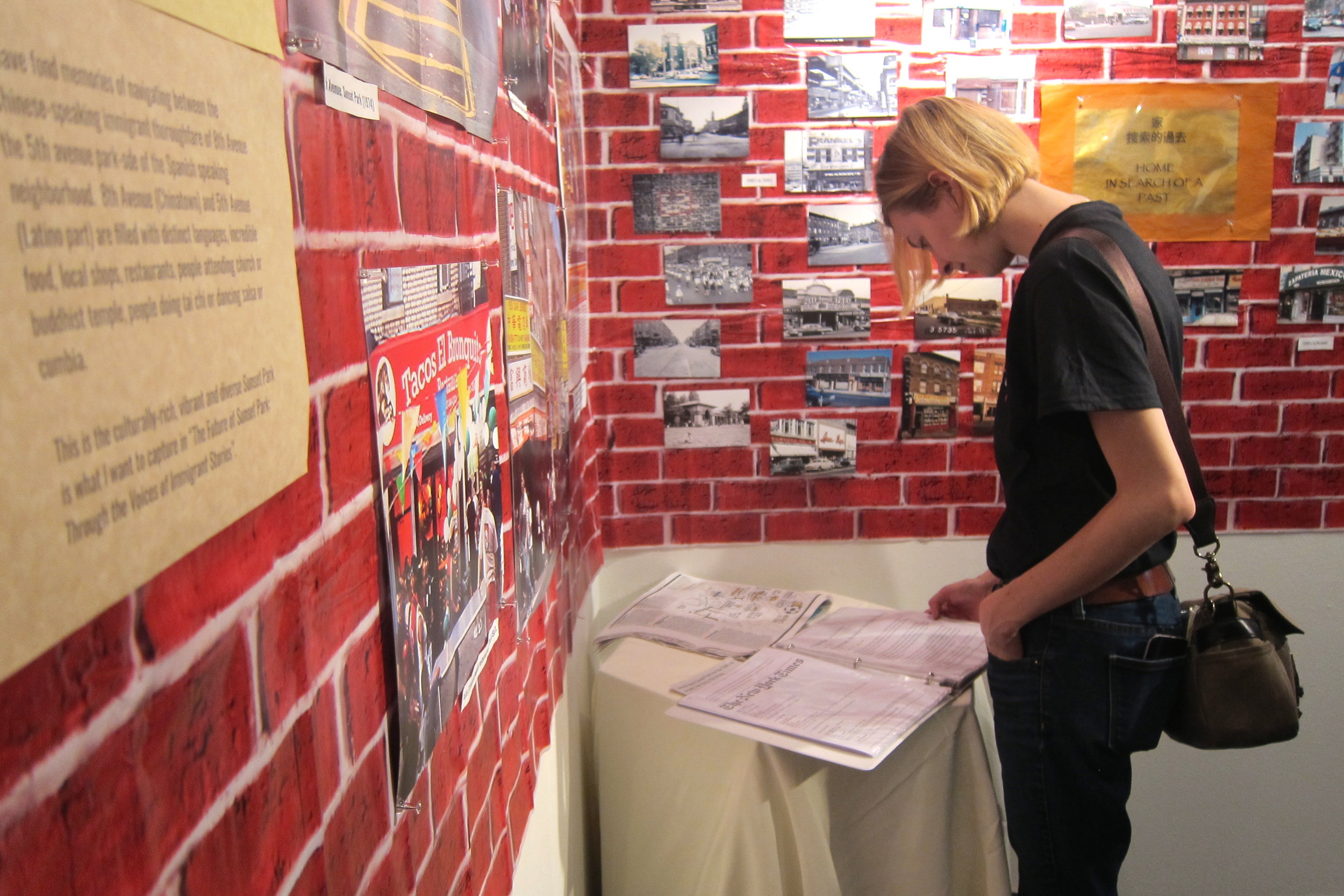(Dis)Placed in Sunset Park: an interactive multimedia project by Betty Yu
(Dis)Placed in Sunset Park is an ongoing interactive multimedia project that explores the impact of urban gentrification and displacement on long time immigrant residents, workers and small businesses in a Sunset Park working class Brooklyn neighborhood of New York City, that I grew up in.
Betty had her first solo show at Open Source Gallery where she had the opportunity to exhibit the first iteration of this project.
Take a Augmented Reality (AR) virtual tour of the Project - CLICK HERE
Check out the videos featured in the AR Tour - CLICK HERE
Check out the Interactive Map - CLICK HERE
Check out the Broadsheet Newspaper - CLICK HERE
Artist Betty Yu with her grandmother in front of their Sunset Park home, circa 1981
Short Description:
(Dis)Placed in Sunset Park is an interactive multimedia exhibition that features short videos of Latinx and Chinese (im)migrants, workers and residents in Brooklyn, New York’s diverse Sunset Park neighborhood. The common theme among their stories is the shared narrative of migration to the U.S., their journey to Sunset Park and their fears of displacement as a result of gentrification. Each story is grounded in the subject’s own sense of home, sanctuary and refuge that they have found in Sunset Park. The title refers to the way people are being “displaced in” their own community as it changes around them; and to some are being crowded into smaller quarters within Sunset Park as well.
My family was part of the early wave of Chinese-American families to move into Sunset Park back in the late 1970’s. Using myself as an entry point into the exhibition and project, I document the impact of gentrification on the cultural fabric, community life and changing racial demographics of Sunset Park through my own story and the stories of others. (Dis)Placed in Sunset Park also examines and interrogates the shifting borders of Sunset Park through archives and maps as it relates to the changing boundaries created by real estate speculators and developers. The mapping aspect of this project highlights contrasting definitions of legitimate space and belonging.
Detailed Description:
(Dis)Placed in Sunset Park is an interactive multimedia project that features short videos of mainly Latinx and Chinese immigrants, workers and residents in Brooklyn, New York’s diverse Sunset Park neighborhood. The common theme among their stories is the shared narrative of migration to the U.S., their journey to Sunset Park and their fears of displacement as a result of gentrification. Each story is grounded in the subject’s own sense of home, sanctuary and refuge that they have found in Sunset Park. The title refers to the way people are being “displaced in” their own community as it changes around them; and to some are being crowded into smaller quarters within Sunset Park as well.
Visitors can take a virtual tour of Sunset Park and unlock the stories of people who live and work there by using augmented reality technology (AR) app. The virtual tour features video stories, images, text and audio about the neighborhood.
The project exists as a platform for everyday people who are directly impacted by immigration and gentrification in the neighborhood by providing an outlet to express what Sunset Park means to them and what their hopes are for the future of the community. My hope is that these stories will reach the broader community and general public.
This project features a wide range of stories and perspectives from tenants, renters, homeowners, workers, small business owners, teachers, youth and community leaders and activists. Stories will feature people from Mexico, China, Ecuador, Puerto Rico as well as other parts of the Caribbean and Central America.
Artist Statement:
I grew up in Sunset Park, Brooklyn to Chinese working class immigrant parents. I felt privileged to have grown up in the 1980’s and 90’s in a neighborhood where I had friends from all backgrounds -- mainly Puerto Rican, Dominican, Chinese and European.
New York City has experienced accelerated gentrification in the last fifteen years. Working class and immigrant families are being displaced and uprooted from where they live and work. As someone raised in Sunset Park, I am concerned about the way the cultural fabric and life I have known for decades may be transformed in the coming decades.
Growing up I straddled what was often referred to as the “Two Sunset Parks” - the Chinatown part and Latinx section, with 6th Avenue as the dividing line. Growing up in the neighborhood I had Chinese and Latino friends. I have fond memories of navigating between the Chinese-speaking immigrant thoroughfare of 8th Avenue and the Spanish-speaking park-side along 5th avenue. On the streets of 8th Avenue (Chinatown) and 5th Avenue (the Latinx neighborhood) I could hear diverse languages being spoken, and see distinct restaurants, hair salons, bakeries, churches, buddhist temples, groceries, clothing shops, and more. Entering the park in Sunset Park on a weekend afternoon within just 10 minutes it’s common to see people doing tai chi, barbequing, playing soccer, and dancing. This is the culturally-rich, vibrant and diverse world I intended to capture in (Dis)Placed in Sunset Park.
Of course not everything has been easy in this neighborhood. There were always racial tensions and frictions between different immigrant waves. Back in the late 1990s and early 2000s there were dozens of garment factories operating out of warehouses and garages in the industrial parts of the area. Folks like my mother worked long hours for very low wages in these sweatshops. However rents and costs of living were still reasonable.
The very block I grew up on is being transformed before my eyes.
Today, I feel the land shifting rapidly beneath my feet. The Latinx area is being hit hard by the massive gentrification caused by the multi-million dollar Industry City development. Industry City replaced Bush Terminal, a manufacturing, shipping and warehousing complex that was a site for employment of thousands of blue-collar U.S-born and immigrant laborers from the early 1900’s up until the 1970s. Recently real estate developers have rebranded Industry City as an industrial waterfront for a “maker” innovation economy centered on art, high fashion, design, film and TV, tech startups, and specialized food sectors. The Chinatown locale where I grew up is also affected. Banks in China, international real estate developers and domestic investors are buying up residential and business properties and converting them into luxury condos, shopping centers, a tourist-oriented Chinatown gateway and other large capital ventures. These impositions are not meant to serve working class immigrants like my parents who live there. Instead these changes are calculated to replace the people there with higher income new inhabitants. Meanwhile, the Sunset Park Chinese population is expanding, absorbing low-income Chinese displaced from Manhattan’s Chinatown and other regions. The long-time Chinese residents are subject to rising rents and some of them, along with these newcomers, are being “displaced into” Single Room Occupancies (SRO) run by unscrupulous landlords.
Counter Mapping and Shifting Borders
The Brooklyn neighborhood now known Sunset Park was home to the First People’s nation of the Lenape-Algonquian people, of whom the Canarsee were an ethnic neighborhood. They were the first known inhabitants of the area. Sunset Park has always been a waterfront community. The proximity to the harbor has been a key factor in the life of Sunset Park. People gravitated to this land because of fertile soil for farming and easy access to the river for trade. At the turn of the 20th century Bush Terminal (now know as “Industry City”) by the waterfront was a major hub for shipping, warehousing and manufacturing employing thousands of immigrants from all over Europe. Later Puerto Ricans and immigrants from Latin America and China worked there, mainly in the garment factories.
The parameters of the Sunset Park neighborhood are 17th Street on the north, 64th street on the South, 8th avenue to the east, and the waterfront to the west. The name “Sunset Park” was taken from the large park that was built in the 1890s. The entire neighborhood was officially given this name in the 1960s when it was designated a federal poverty area eligible for funding. The area also includes Greenwood Cemetery which was built in 1838.
(Dis)Placed in Sunset Park examines and interrogates the shifting borders of Sunset Park as it relates to the changing boundaries for plans created by real estate speculators and developers. The mapping aspect of this project highlights contrasting definitions of legitimate space and belonging. For example, earlier city maps of the neighborhood show a much larger Sunset Park than the newer maps that constricts it to much narrower boundaries. Who are the decision makers behind these new development plans and proposed zoning policy changes? Who should new construction and planning serve? Is it meant to the serve established communities? Is it democratic to upend existing residential property, cultures, and ways of life because it enhances returns on finance and real estate capital?
Theories of counter cartography and counter mapping have influenced my work. Maps are accessible and are widely thought of as objective blueprints. They carry an authority that other forms of art and storytelling do not. ‘Counter-mapping’ is a community-led map-making process where people appropriate the techniques of formal mapping used by government and industry and lift up underrepresented people, uncover untold histories, and bring to focus places that not recognized by dominant narratives. Through this project, I hope to challenge the power structure’s notion of maps: Who creates maps? Who’s stories are told by them? Why are some sites highlighted and deemed important while others are unseen or ignored?
In the last few decades real estate developers have renamed parts of Sunset Park “Greenwood Heights” and “South Slope” to make the neighborhood more desirable to newcomers by emphasizing its proximity to the affluent and desirable neighborhood of Park Slope.
Sunset Park Neighborhood, Map of the City of Brooklyn from 1868 (shows the boundaries of Sunset Park as 17th Street to 64th Street)
In 1985 a "Greenwood Heights Association" offered Greenwood Condos in Park Slope South. A 1986 development called Greenwood Terrace billed itself as "Park Slope's Newest Development!" despite its location on 22nd Street, a block from the cemetery. (Source: The Evolving Name and Boundaries of Greenwood Heights, Curbed NY, 8/28/13)
New York City Community Board 7’s Map of Sunset Park from 1969 showing the same original boundaries of the Sunset Park.
“One relatively well-accepted definition has Greenwood Heights extending from the Prospect Expressway to 36th Street and from the harbor to Prospect Park West.”
(Source: New York Times, 8/28/11)
The area between 15th and 24th Street and from 4th Ave to Prospect Park West was rezoned and renamed Park Slope South in 2005.
‘But with a half dozen buildings billing themselves as "luxury" condominiums opening soon, and even more under construction, this long time no man's land south of Park Slope won't be out of the way for long. Some brokers and restaurant owners sell it as "South Slope," or the more realistic "South South Slope."’
(Source: South of Park Slope, a Neighborhood Awakens, New York Sun 5/17/07)
Redlining
Sunset Park was considered “undesirable” and was redlined back in the 1930’s by the The Home Owners’ Loan Corporation. It was a government agency that “pioneered the practice of redlining, selectively granting loans and insisting that any property it insured be covered by a restrictive covenant — a clause in the deed forbidding the sale of the property to anyone other than whites. Millions of dollars flowed from tax coffers into segregated white neighborhoods.” Ta-Nehisi Coates explains.
To determine which neighborhoods qualified for investment HOLC gave grades to different areas of the city. A Grade "A" neighborhood was green signaled a best bet for housing investment, Grade "B" neighborhoods were blue, meaning "still desirable" , Grade "C" neighborhoods were yellow and "definitely declining" and -Grade"D" neighborhoods were red, or "hazardous" They evaluated areas based on the "threat of infiltration of foreign-born, negro, or lower grade population." This means that green areas were green not just because of the quality of the buildings, but because, as Ta-Nehisi Coates reminds us, they lacked "a single foreigner or Negro"
What has become known as Sunset Park was labeled Grade D. On top of this, after the war the neighborhood experienced white flight and de-industrialization, and by 1970, like much of New York City, it was in decay. In the 1960s, the entire neighborhood was officially given the name “Sunset Park” by being designated a federal poverty area and receiving federal funds. New immigrants, people of color and other working-class ethnic groups who stayed in the neighborhood throughout built it back up.
Redlined + Hazardous: the author’s Sunset Park home and family photo in front of their home in the early 80’s. Image by Betty Yu, 2021
The Fight Against Gentrification:
One of the things I love most about the neighborhood where I grew up is its diversity. The vast majority of residents are people of color, immigrants and working class European Americans. It was one of those working class communities where immigrant families could actually afford to live and even purchase a home if they were so fortunate.
Since the 1950s Latinos, specifically Puerto Ricans, have been living in Sunset Park. Today, the majority of immigrants (as opposed to Puerto Rican migrants) come from the Dominican Republic, Mexico and other parts of Central and South America like Ecuador, Colombia, Perú, El Salvador, and Nicaragua.
Between 1990 and 2014 the number of immigrants living in Sunset Park doubled.
According to the recent census almost 50 percent of the neighborhood is Latinx and about 40 percent is Asian. In addition, there is a growing Arabic speaking community coming mainly from Lebanon, Palestine, Syria, Egypt, Yemen, Morocco and other parts of the Middle East.
My family was part of the first wave of Cantonese-speaking Chinese families to move into Sunset Park back in the late 1970’s. Today, most of the people immigrating from China are coming from Fujian province. Asian residents have been the fastest-growing group. The number of Asians in the area increased by 241 percent between 1990 and 2014. By 2014, Asians accounted for more than one-third of the population. Sunset Park is now home to one of the largest concentrations of Chinese residents New York City, surpassing the number living in Manhattan’s Chinatown.
Today, however, the community is at risk. Major plans are underway to gentrify the Sunset Park neighborhood. Developers have been pushing to change zoning and land use laws so that developers can demolish existing low structures to build taller luxury housing. Many parts of Sunset Park are still zoned for manufacturing and not for residential or commercial use. Zoning laws may seem unimportant at first. In fact, it is vital to organize our communities take control of them.
According to scholar and former Sunset Park resident Tarry Hum, “Brooklyn is the symbolic capital of New York City’s ‘maker’ movement comprised of artisans and artists, designers, craftsmen, builders, innovators, and inventors. The adaptive reuse of the borough’s extensive industrial waterfront is integral to an innovation economy that derives social and economic value from place-based global branding.”
Industry City (formerly Bush Terminal) is a $1 billion venture comprised of 16 factory loft buildings of 6-12 stories with 6.5 million square feet of floor space across 7 blocks covering 32nd to 39th Street by the waterfront. Developers are trying to position it as one of the nation’s largest innovation maker hubs. This innovation economy ecosystem is centered on “art and design, film and TV, retail, fashion, technology, and specialty food sectors”, according to Hum.
The impact of Industry City is already palpable, displacing Sunset Park’s working class residents of color and many small businesses. Jamestown, the developer behind Industry City, has been pushing to rezone the neighborhood so it can build more luxury buildings, hotels and commercial structures. A few blocks south of Industry City is Sunset Industrial Park which is being redeveloped into a distribution center attracting corporations like FedEx, Verizon and many others.
There is also development on the Chinatown side of Sunset Park where I grew up by 8th Avenue. Since 2012, overseas Chinese and domestic investors from Flushing, Queens along with banks from China have been the major force behind the gentrification. Much of this development is happening one block away from my family’s house. On 62nd Street and 8th Avenue there is a mega-development underway called The Eighth Avenue Center that will include a 17-story office building, a 10-story hotel, condo buildings and a shopping center.
A Chinatown arch called the Brooklyn Friendship Archway may be built on 61st Street and 8th Avenue. It is a “gift” from Beijing’s Chaoyang District, yet $2 million taxpayer dollars will be needed to subsidize the project. The archway will only boost tourism and real estate values while pushing out working class residents.
And finally there is the Winley Plaza Condominium, under development on 8th Avenue and 56th Street, outfitted with luxury condos and medical offices, that will cost $33 million to build. In addition to these large developments, dozens of other properties are being bought by developers to turn into luxury condos and hotels. These developers are pushing for changes in zoning laws around 8th Avenue so they can build more residential and commercial spaces. In August 2018, a plan detailing the scope of work for the Eighth Avenue Center mall was released and public hearings will be scheduled.
This project draws on people’s recollection and remembrance of the past as they live in the present and articulate their hopes for the future of the neighborhood.
Sunset Park is only a microcosm of what is happening all around New York City and beyond. Sunset Park like so many other diverse communities are being homogenized by waves of gentrification.
The stakes are high. The fight against gentrification is real. The fight is now.
Resources and what we can do:
To better understand zoning and land use policy and its impact on gentrification:
www.bettyyu.net/displacedresources
To get involved in resisting displacement in Sunset Park Brooklyn, contact the following groups:
UPROSE: Founded in 1966, UPROSE is Brooklyn's oldest Latino community-based organization. An intergenerational, multi-racial, nationally recognized community organization, UPROSE promotes sustainability and resiliency in Brooklyn's Sunset Park neighborhood through community organizing, education, indigenous and youth leadership development, and cultural/artistic expression. https://www.uprose.org/
POWWA: Protect Our Working Waterfront Alliance (POWWA) is a broad coalition of residents, businesses, labor, housing advocates, faith leaders, and others. All are committed to protecting the industrial character of the Sunset Park waterfront to: protect and expand career-track manufacturing jobs, protect working class residents from displacement, and develop for climate resilience. https://www.uprose.org/antidisplacement/
Coalition to Protect 8th Avenue is a group of residents, activists and citizens who are concerned about how the new commercial developments in the Chinatown part of Sunset Park will negatively impact the current working class Chinese immigrant community. https://protect8thavecoalition.wordpress.com/
This project has been developed through Betty Yu's artist residencies at International Studio and Curatorial Program (ISCP) in New York City, Skidmore College’s John B. Moore Documentary Studies Collaborative and SPACE on Ryder Farm.
Below are from images from various exhibitions of (Dis)Placed in Sunset Park - at the International Studio and Curatorial Program (ISCP) Open Studio in Brooklyn, NYC; Skidmore College’s Case Gallery in Saratoga Springs, NY; and Open Source Gallery in Brooklyn, NYC. Images courtesy of Betty Yu, John Antush, Di Cui and Jason Wyche/BRIC.
(Dis)Placed in Sunset Park at 2019 BRIC Biennial
DOWNLOAD THE NEWSPRINT
(Dis)Placed in Sunset Park at Open Source Gallery in Brooklyn (2018) and Case Gallery at Skidmore College, NY (2017)
SPANISH:
(Des)Plazado de Sunset Park (un proyecto multimedia de Betty Yu)
Sobre el proyecto
(Des)Plazado de Sunset Park es un proyecto multimedia interactivo que presenta videos cortos de inmigrantes, trabajadores y residentes principalmente latinos y chinos en el diverso vecindario Sunset Park en Brooklyn en la ciudad de Nueva York. El tema común entre sus historias es la narración compartida de la migración a los EE. UU., sus trayectos a Sunset Park y el temor al desplazamiento como resultado de la gentrificación. Cada historia se basa en el sentido de hogar, santuario y refugio del sujeto que han encontrado en el vecindario de Sunset Park.
El proyecto es una plataforma para que el pueblo común que ha sido directamente afectada por la inmigración y la gentrificación en el vecindario tenga una salida para expresar lo que Sunset Park significa para ellos y cuáles son sus esperanzas para el futuro de la comunidad. Mi esperanza es que estas historias lleguen a la comunidad más amplia de Sunset Park, así como al público en general.
El proyecto presenta una amplia gama de historias y perspectivas de inquilinos, propietarios de vivienda, trabajadores, propietarios de pequeñas empresas, maestros, líderes y activistas juveniles y comunitarios. Las historias viene de (in)migrantes de México, China, Ecuador, Puerto Rico y otras partes de América Central.
Declaración de Artista
Crecí en Sunset Park, Brooklyn, con padres inmigrantes de clase trabajadora chinos. Me sentí privilegiada de haber crecido en los años 80 y 90 en un barrio donde tenía amigos de todas partes, principalmente puertorriqueños, dominicanos, chinos y europeos.
La ciudad de Nueva York ha experimentado en un tipo de gentrificación acelerada en los últimos quince años, con comunidades de clase trabajadora e inmigrantes desplazadas y desarraigadas de sus hogares y comunidades. El Sunset Park de Brooklyn está cambiando rápidamente. Como alguien que se crió en Sunset Park, me preocupa el impacto de la gentrificación en el vecindario y cómo el tejido cultural, la vida comunitaria y la demografía de Sunset Park se han transformado y continuarán transformándose en las próximas décadas.
Al crecer me senté entre lo que lo que se refiere a "Los dos Sunset Parks": la parte de Chinatown y la parte Latinx, con la 6ª avenida como línea divisoria. Al crecer en el vecindario, tuve amigos chinos y latinos. Tengo buenos recuerdos de navegar entre la calle de inmigrantes hablando chino de la avenida 8 y inmigrantes hablando español en la 5ta avenida. Las calles de la 8ª avenida (Chinatown) y la 5ª avenida (la parte Latinx) estaban llenas de diversos idiomas, comidas, peluquerías, panaderías, iglesias, templos budistas, bodegas, tiendas de ropa y mucho más.
Mi propio bloque en el que crecí se está transformando ante mis propios ojos.
La gentrificación ha generado un golpe masivo para la comunidad Latinx causada por el desarrollo multimillonario de Industry City. Industry City de hoy en día era en realidad Bush Terminal, un lugar empleando a miles de trabajadores nacidos en Estados Unidos e inmigrantes que trabajaban en navieras y la fabricación hasta la década de los 70s. Promotores inmobiliarios han rebautizado el zona como un centro para la economía centrada en el arte, la alta costura, el diseño, el cine y la televisión, nuevas empresas tecnológicas y de sectores especializado en comidas. La parte de Chinatown, donde crecí también se ve afectada. Gran cantidad de dinero proveniente de bancos de China en el extranjero, desarrolladores de bienes raíces e incluso inversionistas nacionales están comprando propiedades residenciales y comerciales y convirtiéndolas en condominios de lujo, centros comerciales, una entrada turística de Chinatown y otras empresas comerciales.
Estos establecimientos no fueron hechos para inmigrantes de la clase trabajadora, como mis padres, que todavía viven allí, sino para una clase más alta con mayores ingresos que esperan atraer. Es cierto que la población china de Sunset Park se está expandiendo. Muchos son desplazados del barrio chino de Manhattan y otros lugares. Pero también es cierto que las personas están siendo sometidas a rentas cada vez más altas y viven en ocupaciones de habitaciones individuales (SRO, por sus siglas en inglés), donde las débiles leyes de vivienda para inquilinos favorecen a los propietarios.
Sunset Park es un ejemplo de lo que sucede en toda la ciudad de Nueva York. Sunset Park, al igual de muchas otras comunidades diversas, está siendo homogeneizada por oleadas de gentrificación. Estoy realmente interesada en cómo los inmigrantes crean una sensación de "hogar" en los EE. UU., especialmente cuando han sido arrancados de su hogar por razones económicas o políticas. Muchas de estas familias inmigrantes que se ven obligadas a mudarse debido al aumento de las rentas son las más afectadas por las múltiples capas del desplazamiento global y local impulsado por el capitalismo. Este proyecto se basa en el recuerdo de la gente del pasado tal como viven en el presente y articula sus esperanzas para el futuro del vecindario.
CHINESE:
《“失”所于日落公园》(一个多媒体的项目,由 余紅碧 <Betty Yu> 制作)
關於此项目
《“失”所于日落公园》是一个互动多媒体项目,透过多条短片去记录居于纽约市布碌仑多元化的日落公园的社群 — 拉丁美洲和华人移民、工人和居民。他们故事中的共同主题围绕着对美国移民的共享叙述、他们前往日落公园的旅程以及高档化会令他们流离失所的恐惧。每个故事都基于主角如何看待日落公园为他们的家园、避难所和容身之地。
该项目为居于此邻舍受移民和贵族化直接影响的人提供了一个平台,让他们可以提出日落公园对他们的意义,以及他们对社区未来的希望。我希望这些故事能够传播到更广阔的日落公园社区以及普罗大众。
该项目呈现出众多来自租房者、租户、房主、工人、小企业主、教师、青年和社区领袖以及积极分子的故事和观点。故事将以来自墨西哥、中国、厄瓜多尔、波多黎各和中美洲其他地区的“移”民为特色。
艺术家的声明
我在布碌仑的日落公园长大,由华裔移民工人阶级的父母养育成人。 我很荣幸能够于1980年代和 90年代在此社区成长。因此我有来自不同背景的朋友,主要是波多黎各人,多米尼加人,华人和欧洲人。
在过去的十五年里,纽约市经历贵族化加速,工人阶级和移民社区被迫离开家园和社区。
布碌仑的日落公园正在迅速变化。作为在日落公园长大的人,我担心高档化对社区的影响以及日落公园的文化结构,社区生活和人口统计在未来几十年中将如何继续发展。
在成长过程中,我徘徊在通称为“两个日落公园”之间 - 唐人街部分和拉丁美洲部分,以第六大道為分界线。 在小区长大,我有华裔和拉美裔的朋友。 我对航行连接以中文沟通的移民之第八大道和以西班牙语沟通移民居之第五大道有着美好的回忆。 八大道(唐人街)和五大道(拉丁语区)的街道上到处都洋溢着各种语言,独特的食物,美发沙龙,面包店,教,佛寺,杂货店,服装店等等。
此陪伴我成长的街段正在我眼前转变。
价值数百万美元的布碌仑工业城所引致的高档化令拉美族社区承受严重的打击。今天的工业城是由布什码头重建而成,直至70年代雇佣了数千名美籍和新移民航运和制造业工人。地产商将工业城水边地带标签为「创新经济基地」,以艺术、高级时装、设计、电影和电视、科技初创公司及特色食品行业为发展重心。我长大的唐人街部分亦受影响。置于海外及中国的银行、房地产开发商、甚至本土投资者都以大量资金购买民宅和物业,并将其重建为豪华公寓、购物商场、为游客而设的唐人街和其他企业。
这些新设施根本不是为像我父母一般的工人阶级移民而设立,地产商是迎合和希望吸引拥有更高收入的富裕阶层。日落公园的华裔人口的确在上升,但其中许多人是是从曼哈顿唐人街和其他地区被逼迁。住客亦因租金上涨及其它因素而被迫搬进生活拥挤的单人房,承受偏袒房东的屋务法例监管。
日落公园是纽约市贵族化的縮影。就如其他种族多元化的社区,日落公园因贵族化而失去原有的社区特色及面貌,变得单一化。我对新移民如何在美国重创「家」的感觉特别感兴趣,尤其因为他们一般受经济或政治等因素影响,导致他们被迫离开原有的家乡。基于多层资本主义在全球和本地的影响,新移民家庭的房租不断上涨,而逃不过流离失所的命运。此艺术计划收集人们对过去的回忆及表达他们对社区未来的希望。

